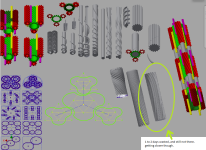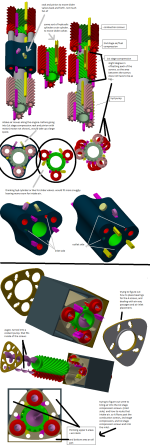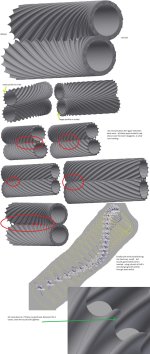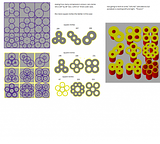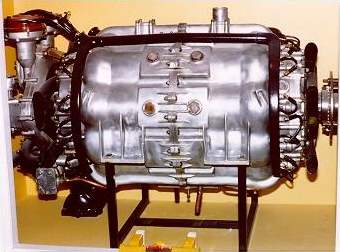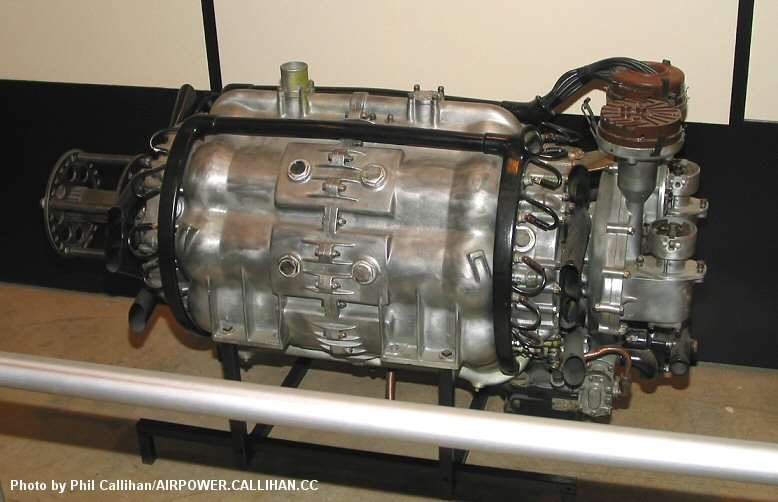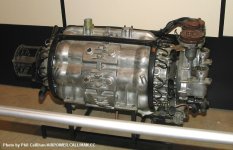OP
boggen
Elite Member
- Joined
- Feb 22, 2011
- Messages
- 3,824
- Location
- Trivoli, IL
- Tractor
- SSTT (Sideways Snake Tain Tractor) and STB (sideways train box) tractor, dirt harvester
links... that helped me....
Pump - Wikipedia, the free encyclopedia
Gas compressor - Wikipedia, the free encyclopedia
Turbofan - Wikipedia, the free encyclopedia
Vacuum pump - Wikipedia, the free encyclopedia
search for "screw pump" on youtube
search for "scroll pump on google then clicking images.
alright, how do i adjust the "blades" so that i can obtain different compression ratios at different RPM's.
do i go with something like a helicopter blade setup. were you can adjust "tilt" or angle of blades. to gain either a more aggressive, straight up. or a less aggressive angle. to say hover in a single spot.
*rubs chin*, i guess it is going to come down. material used. the blades will need strength in themselves from breaking loose, and if say a small pebble / rock, gets in and nails a blade.
i guess i can go with say a bevel gear. (45 degree angle or something)
*rubs chin* starting to think fan blades might be a bad decision when trying to compress air, before fuel is injected and combustion occurs. it is more about. lower RPM's and wanting to keep Pressure up.
with piston/cylinder type of engine, it really does not matter what RPM's the engine runs at, the same compression of air/fuel mixture happens for the most part.
i think would be better off with a different air or air/fuel mixture compressor. that has a better way to build up the pressure and then be able to hold the pressure. being able to hold that pressure, would help deal with, controlled explosions. vs a continually combustion / explosion.
even if it was a continually combustion explosion. being able to supply a higher pressure across a large range of RPM's......
=================
looking at a "scroll pump" for compressing air or air/fuel mixture, and going to have to put it on the "no list" by the motion itself, i would be creating a compaction machine. even if i put multi "scroll pumps" side by side, and off set them. i would never be able to remove the vibration that would be created.
ggrrr then again. even a turbine and compressor for the turbine engine, both would create a vibration. but at what frequency and amplitude of the vibration...
looking at screw pumps. there might be something there. for compressing air or air/fuel mixture.
i came across this video...
a screw pump, engine.
it has nice postive displacement of a screw pump, and would achieve same amount of compression (within reason after wear/tear) over a large range of RPM's. meaning being able to compress air to a point were diesel could be injected and the diesel would exploded based on heat and compression.
the combustion / exhaust side of the screws. looks a tad to "restrictive" in video. and could possibly cause a good amount of efficiency problems. as some of the combustion tries to turn the screws in opposite direction as the combustion tries to works it way back into the compression area of the air or air/fuel mixture. BUT...
with wear and tear, and tolerances (spaces) between the screws get larger. the compression ratio of air or air/fuel mix would go down, and combustion would not have as much effect. but... hhmmssss... how do you compensate? i guess the compressor stage of air or air/fuel would be a longer screw with more points of screws locking. or i could say there is more "stages" that the air would have to go through. each stage would not need as a dramatic effect in how much air is compressed. but rather it is the multi stages and locking between each screw. that would overcome longer wear/tear.
and then on the combustion / exhaust side.... i would assume. wanting to keep things fairly short. part due to amount of heat created, but how fast a explosion happens. and trying to time the explosion, so the screws, fit more in tune with the explosion.
the other issue would be trying to keep things lubricated. both to reduce wear/tear, but also help in sealing some.
if i just sprayed oil right into the "compressor" (inlet side), i would end up having a extremely hot sputtering of oil coming out of the exhaust.
perhaps. i could go with turbine engine like doings. and kinda setup 2 screw pumps (compression stages). first stage. would for most part completely compress the air or air/fuel mixture. right up to the wanted pressure. but before moving on to the second screw pump. put a empty chamber. that is better designed to "retrieve a larger amount of oil" and then the compressed air, would move to 2nd stage. which was also tied directly to the combustion and exhaust screws. doing this would let me push more into the first stage of compression for lubrication, and get perhaps much better sealing to happen. but then when it comes to the 2nd stage of compression, combustion, exhaust. there would be less lubrication, and less sealing. and less hot oil to deal with as it comes out of the exhaust. granted i would loose some efficiency, due to not as good seals in the combustion / exhaust area. due to not as much oil for sealing. but..... i might be able to use a more expensive / costly metal or like. for this last stage. vs the longer first stage (compression stage).
i suppose by also spliting the 2 portions up. i could use different depth of threads on each screw. so 1st stage. has different depth vs the 2nd stage.
i suppose if i wanted to get really complicated. i could put some sort of transmission, between 1st and 2nd stage. so i could control CFM (cubic feet per minute) of air, at given pressure. this would most likely allow me to reach higher efficiency levels. based on different amounts of fuel injected, and in that keep the curves on a graph up to par clear across the wide range of RPM's and horse power, and fuel consumption.
if i placed transmission on generator, and then another transmission on hyd pump. and another transmission on air pump for tires... i could adjust things right down to the finite ability, of what ever the current age computer chips could process data.
hhhmmsss.... i really have been thinking about using the hyd oil lines, and coolant lines, that run the length of the SSTT (60 foot) on both sides of main frame. to help act as cooling. i may setup a better "heat sinks" errr i should say heat exchangers type of thing. ya that could work, and just leave the coolant pump/s and hydraulic oil pump. just constantly running. or rather running as needed. to help cool things.
=================
enough blah blah... the resulting chicken scratches in autodesk from above...
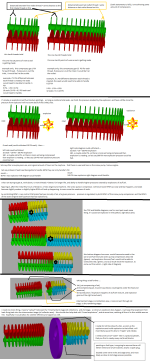
Pump - Wikipedia, the free encyclopedia
Gas compressor - Wikipedia, the free encyclopedia
Turbofan - Wikipedia, the free encyclopedia
Vacuum pump - Wikipedia, the free encyclopedia
search for "screw pump" on youtube
search for "scroll pump on google then clicking images.
alright, how do i adjust the "blades" so that i can obtain different compression ratios at different RPM's.
do i go with something like a helicopter blade setup. were you can adjust "tilt" or angle of blades. to gain either a more aggressive, straight up. or a less aggressive angle. to say hover in a single spot.
*rubs chin*, i guess it is going to come down. material used. the blades will need strength in themselves from breaking loose, and if say a small pebble / rock, gets in and nails a blade.
i guess i can go with say a bevel gear. (45 degree angle or something)
*rubs chin* starting to think fan blades might be a bad decision when trying to compress air, before fuel is injected and combustion occurs. it is more about. lower RPM's and wanting to keep Pressure up.
with piston/cylinder type of engine, it really does not matter what RPM's the engine runs at, the same compression of air/fuel mixture happens for the most part.
i think would be better off with a different air or air/fuel mixture compressor. that has a better way to build up the pressure and then be able to hold the pressure. being able to hold that pressure, would help deal with, controlled explosions. vs a continually combustion / explosion.
even if it was a continually combustion explosion. being able to supply a higher pressure across a large range of RPM's......
=================
looking at a "scroll pump" for compressing air or air/fuel mixture, and going to have to put it on the "no list" by the motion itself, i would be creating a compaction machine. even if i put multi "scroll pumps" side by side, and off set them. i would never be able to remove the vibration that would be created.
ggrrr then again. even a turbine and compressor for the turbine engine, both would create a vibration. but at what frequency and amplitude of the vibration...
looking at screw pumps. there might be something there. for compressing air or air/fuel mixture.
i came across this video...
it has nice postive displacement of a screw pump, and would achieve same amount of compression (within reason after wear/tear) over a large range of RPM's. meaning being able to compress air to a point were diesel could be injected and the diesel would exploded based on heat and compression.
the combustion / exhaust side of the screws. looks a tad to "restrictive" in video. and could possibly cause a good amount of efficiency problems. as some of the combustion tries to turn the screws in opposite direction as the combustion tries to works it way back into the compression area of the air or air/fuel mixture. BUT...
with wear and tear, and tolerances (spaces) between the screws get larger. the compression ratio of air or air/fuel mix would go down, and combustion would not have as much effect. but... hhmmssss... how do you compensate? i guess the compressor stage of air or air/fuel would be a longer screw with more points of screws locking. or i could say there is more "stages" that the air would have to go through. each stage would not need as a dramatic effect in how much air is compressed. but rather it is the multi stages and locking between each screw. that would overcome longer wear/tear.
and then on the combustion / exhaust side.... i would assume. wanting to keep things fairly short. part due to amount of heat created, but how fast a explosion happens. and trying to time the explosion, so the screws, fit more in tune with the explosion.
the other issue would be trying to keep things lubricated. both to reduce wear/tear, but also help in sealing some.
if i just sprayed oil right into the "compressor" (inlet side), i would end up having a extremely hot sputtering of oil coming out of the exhaust.
perhaps. i could go with turbine engine like doings. and kinda setup 2 screw pumps (compression stages). first stage. would for most part completely compress the air or air/fuel mixture. right up to the wanted pressure. but before moving on to the second screw pump. put a empty chamber. that is better designed to "retrieve a larger amount of oil" and then the compressed air, would move to 2nd stage. which was also tied directly to the combustion and exhaust screws. doing this would let me push more into the first stage of compression for lubrication, and get perhaps much better sealing to happen. but then when it comes to the 2nd stage of compression, combustion, exhaust. there would be less lubrication, and less sealing. and less hot oil to deal with as it comes out of the exhaust. granted i would loose some efficiency, due to not as good seals in the combustion / exhaust area. due to not as much oil for sealing. but..... i might be able to use a more expensive / costly metal or like. for this last stage. vs the longer first stage (compression stage).
i suppose by also spliting the 2 portions up. i could use different depth of threads on each screw. so 1st stage. has different depth vs the 2nd stage.
i suppose if i wanted to get really complicated. i could put some sort of transmission, between 1st and 2nd stage. so i could control CFM (cubic feet per minute) of air, at given pressure. this would most likely allow me to reach higher efficiency levels. based on different amounts of fuel injected, and in that keep the curves on a graph up to par clear across the wide range of RPM's and horse power, and fuel consumption.
if i placed transmission on generator, and then another transmission on hyd pump. and another transmission on air pump for tires... i could adjust things right down to the finite ability, of what ever the current age computer chips could process data.
hhhmmsss.... i really have been thinking about using the hyd oil lines, and coolant lines, that run the length of the SSTT (60 foot) on both sides of main frame. to help act as cooling. i may setup a better "heat sinks" errr i should say heat exchangers type of thing. ya that could work, and just leave the coolant pump/s and hydraulic oil pump. just constantly running. or rather running as needed. to help cool things.
=================
enough blah blah... the resulting chicken scratches in autodesk from above...


